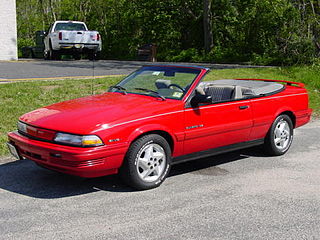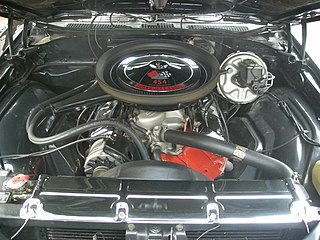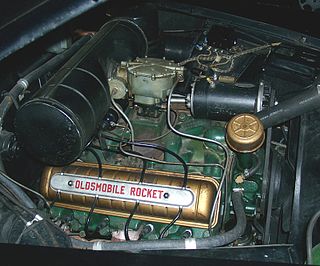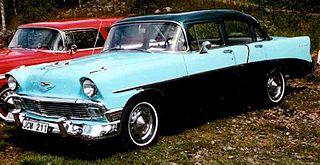
The Chevrolet Beauville was originally a station wagon option for the 1954 Chevrolet Bel Air. The name was later resurrected as a full-size van option for the Chevrolet Van in 1970. Both were related to the lower trim level Chevrolet Townsman.

The Chevrolet Beauville was originally a station wagon option for the 1954 Chevrolet Bel Air. The name was later resurrected as a full-size van option for the Chevrolet Van in 1970. Both were related to the lower trim level Chevrolet Townsman.
In 1954 Chevrolet introduced the 4-door Beauville Wagon as an option for the Bel Air Line. It came standard with a 6-cylinder engine and featured woodgrain trim around the side windows.
In 1956 the Beauville became a wagon option for the Chevrolet 210 as well.
| Type of Beauville | Number made | Standard Price | Seating capacity |
|---|---|---|---|
| 1956 4-door 210 Beauville Wagon | 17,988 | 6-cylinder= $2,348 V8= $2447 | 9 passengers |
| 1956 4-door Bel Air Beauville Wagon (V8 and 6-cylinder Have different Chrome strips) | 13,279 | 6-cylinder= $2,482 V8= $2581 | 9 passengers |
Chevrolet Station wagons offered a wide variety of engines rated from the 140 bhp (100 kW) 6-cylinder to the 225 hp (168 kW) V8.
One base engine Chevrolet offered in 1956 was a 235.5-cubic-inch (3,859 cc) 6-cylinder engine with a cast-iron block and a compression ratio of 8.0:1. It was carbureted, with a Rochester single barrel carburetor and produced 140 brake horsepower (100 kW) power at 4200 revolutions per minute. Another base engine offered by Chevrolet in 1956 was a 265-cubic-inch (4,340 cc) V8 with a 2-barrel carburetor with 162 brake horsepower (121 kW) at 4400 rpm.
In 1956 two other 265-cubic-inch (4,340 cc) V8s were offered but both had a 9.25:1 compression ratio, 4-barrel carburetors, and a dual exhaust. The Turbo-Fire 225 engine was equipped with 2 Carter 4-barrel carburetors and produced 225 hp (168 kW) at 5200 rpm while the Turbo-Fire 205 engine had a single 4-barrel carburetor with a peak 205 hp (153 kW) at 4600 rpm.
In 1957 the Beauville station wagon was not offered in the Bel Air line, only in the 210.
| Type of Beauville | Number sold | Standard Price | Seating capacity |
|---|---|---|---|
| 1957 4-door 210 Beauville wagon | 21,803 | 6-cylinder= $2,563 V8= $2663 | 9 passengers |
In 1957 the engines offered by Chevrolet in the 210 Beauville were a 235.5-cubic-inch 6-cylinder with 140 hp (104 kW), a 265-cubic-inch V8 with 162 hp (121 kW), and a number of 283-cubic-inch V8s, the most powerful being the super turbo-fire 283 reached 283 hp (211 kW). The super turbo-fire 283 was a fuel-injected engine that was a $550 option back in 1957. [2] [3]

The Buick Skylark is a passenger car formerly produced by Buick. The model was made in six production runs, during 46 years, over which the car's design varied dramatically due to changing technology, tastes, and new standards implemented over the years. It was named for the species of bird called skylark.

The Pontiac Sunbird is a model line that was manufactured and marketed by Pontiac from the 1976 to the 1994 model years. Loosely deriving its name from the Pontiac Firebird, the Sunbird was introduced as the eventual replacement for the Pontiac Astre, replacing it entirely in 1978 as the smallest Pontiac.

The Chevrolet Bel Air is a full-size car produced by Chevrolet for the 1950–1975 model years. Initially, only the two-door hardtops in the Chevrolet model range were designated with the Bel Air name from 1950 to 1952. With the 1953 model year, the Bel Air name was changed from a designation for a unique body shape to a premium level of trim applied across a number of body styles. The Bel Air continued with various other trim level designations, and it went from a mid-level trim car to a budget fleet sedan when U.S. production ceased in 1975. Production continued in Canada, for its home market only, through the 1981 model year.

The Pontiac Catalina is a full-size automobile produced by Pontiac from 1950 to 1981. Initially, the name was a trim line on hardtop body styles, first appearing in the 1950 Chieftain Eight and DeLuxe Eight lines. In 1959, it became a separate model as the "entry-level" full-size Pontiac.

The Chevrolet El Camino is a coupé utility vehicle that was produced by Chevrolet between 1959–60 and 1964–1987. Unlike a standard pickup truck, the El Camino was adapted from the standard two-door Chevrolet station wagon platform and integrated the cab and cargo bed into the body.
The Y-block engine is a family of overhead valve V8 automobile engines produced by Ford Motor Company. The engine is well known and named for its deep skirting, which causes the engine block to resemble a Y. It was introduced in 1954 as a more modern replacement for the outdated side-valved Ford Flathead V8 and was used in a variety of Ford vehicles through 1964.

The Chevrolet "big block" engine is a term for a series of large-displacement, naturally-aspirated, 90°, overhead valve, gasoline-powered, V-8 engines; that were developed and produced by the Chevrolet Division of General Motors, from the 1950s until present.

The Chevrolet small-block engine is a series of gasoline-powered, V-8 automobile engines, produced by the Chevrolet division of General Motors between 1954 and 2003, using the same basic engine block. Referred to as a "small-block" for its size relative to the physically much larger Chevrolet big-block engines, the small block family spanned from 262 cu in (4.3 L) to 400 cu in (6.6 L) in displacement. Engineer Ed Cole is credited with leading the design for this engine. The engine block and cylinder heads were cast at Saginaw Metal Casting Operations in Saginaw, Michigan.

The Pontiac V8 engine is a family of overhead valve 90° V8 engines manufactured by the Pontiac Division of General Motors Corporation between 1955 and 1981. The engines feature a cast-iron block and head and two valves per cylinder. Engine block and cylinder heads were cast at Saginaw Metal Casting Operations then assembled at Tonawanda Engine before delivery to Pontiac Assembly for installation.

The Oldsmobile V8, also referred to as the Rocket, is series of engines that was produced by Oldsmobile from 1949 to 1990. The Rocket, along with the 1949 Cadillac V8, were the first post-war OHV crossflow cylinder head V8 engines produced by General Motors. Like all other GM divisions, Olds continued building its own V8 engine family for decades, adopting the corporate Chevrolet 350 small-block and Cadillac Northstar engine only in the 1990s. All Oldsmobile V8s were manufactured at plants in Lansing, Michigan while the engine block and cylinder heads were cast at Saginaw Metal Casting Operations.

The Buick V8 is a family of V8 engines produced by the Buick division of General Motors between 1953 and 1981. The first version replaced the Buick straight-eight. Displacements vary from 215 cu in (3.5 L) to 455 cu in (7.5 L) for its last big block in 1976. All are naturally aspirated OHV pushrod engines, except for an optional turbocharged version of the short-lived 215 used in the 1962-63 Oldsmobile Jetfire.

The Chevrolet Delray, named after the Delray neighborhood of Detroit, Michigan, debuted in 1954 as an optional trim level on two-door models of Chevrolet's mid-range 210 series of cars. In 1958, it became a distinct series of its own at the bottom of Chevy's lineup, and added a four-door sedan, and sedan delivery, but it only remained in production for that model year.

The Chevrolet Brookwood is a series of full-size station wagons produced by Chevrolet from 1958 to 1961, and again from 1969 to 1972. It debuted in 1958 as Chevrolet's mid-range model in its station wagon lineup, positioned between the less expensive Yeoman and more luxurious Nomad station wagons. After the Yeoman was discontinued in 1959, the Brookwood was subsequently demoted to entry-level status, before going out of production altogether in 1961. It made a brief reappearance from 1969 and 1972, once again as the least-expensive wagon in Chevrolet's lineup.

The 1957 Chevrolet is a car that was introduced by Chevrolet in September 1956 for the 1957 model year. It was available in three series models: the upscale Bel Air, the mid-range Two-Ten, and the One-Fifty. A two-door station wagon, the Nomad, was produced as a Bel Air model. An upscale trim option called the Delray was available for Two-Ten 2-door sedans. It is a popular and sought after classic car. These vehicles are often restored to their original condition and sometimes modified. The car's image has been frequently used in toys, graphics, music, movies, and television. The '57 Chevy, as it is often known, is an auto icon.

The Chevrolet Corvette (C1) is the first generation of the Corvette sports car produced by Chevrolet. It was introduced late in the 1953 model year, and produced through 1962. This generation is commonly referred to as the "solid-axle" generation, as the independent rear suspension did not appear until the 1963 Stingray.

The Chevrolet One-Fifty was the economy/fleet model of the Chevrolet car from 1953 until 1957. It took its name by shortening the production series number (1500) by one digit in order to capitalize on the numerical auto name trend of the 1950s. The numerical designation "150" was also sporadically used in company literature. It replaced the Styleline Special model available in previous years. This model was dropped following the 1957 model year and replaced by the Delray.
The Chevrolet Kingswood was a 4-door station wagon produced by Chevrolet in 1959 and 1960, and again from 1969 to 1972 built on the GM B Body platform.

The Chevrolet 210 or Two-Ten is a midrange car from Chevrolet that was marketed from 1953 until 1957. It took its name by shortening the production series number 2100 by one digit in order to capitalize on the 1950s trend toward numerical auto names. The numerical designation "210" was also sporadically used in company literature. It replaced the Styleline DeLuxe model available in previous years. The 210 was discontinued after the 1957 model year to be replaced by the Biscayne.

The Chevrolet Impala are full-size automobiles produced by Chevrolet for the 1965 through 1970 model years. The 1965 Impala was all new, while the 1967 and 1969 models featured new bodies on the same redesigned perimeter frame introduced on the 1965 models. All Impalas of this generation received annual facelifts as well, distinguishing each model year. Throughout the early 1960s, Chevrolet's basic body designs became increasingly subtle, while the bright trim that was part of the Impala package added more than a touch of luxury to the look. The same pattern was followed in the interiors, where the best materials and equipment Chevrolet had to offer were displayed. In short, the Impala was on its way to becoming a kind of junior-grade Cadillac, which, for both the company and its customers, was just fine.

In automobile parlance, Tri-Five refers to the 1955, 1956 and 1957 Chevrolet automobiles, in particular, the 150, 210, Bel Air, and Nomad. Revolutionary in their day, they spawned a cult following that exists in clubs, websites and even entire businesses that exclusively cater to the enthusiasts of the Tri Five automobiles. All featured a front-engine, rear-wheel-drive layout. They remain some of the most popular years for collectors and hot rodders.